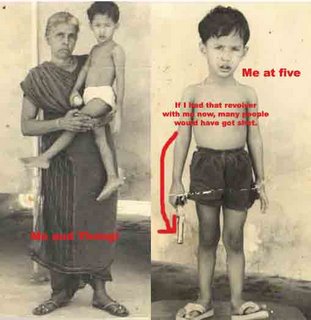Part 4 of my life in Wadi

I have mentioned about LTRT and STRT type of quarters in an earlier post. By the time I got admitted to school, we had shifted from LTRT 3/5 to STRT 31/8 which as I have already mentioned was to be my home for a large part of my life. There were changes in my school after the Sisters of St.Anne took over the reins of the school. But I will talk about it later. Let me ramble a bit on Wadi and some people whom I remember from those times for now.
We, in the ACC colony didn’t mix much with the local population atleast those who were not WKPs. For WKPs all Wadiites were one and we knew neither caste nor creed, religion nor language. THAT was real secularism. Wadi was surrounded by places like Rawoor, Halkatta, Tanda (where the Banjara or Lambada people lived) etc. The major crop was Jawari – I think that’s sorghum bicolor in botanese -, groundnuts and tur dal – cajanus cajan – and though Wadi was said to be in the midst of the Black cotton soil belt, I personally haven’t seen a single cotton tree in Wadi. Most of the time the ground was cracked and the sun shining down bright on the earth, and hardly anything grew on the hostile soil. A lone farmer ploughing his measly field with his measly bull as the sun was setting was one common sight. It did rain sometimes. A river called Kagna which flowed between Wadi and Shahabad used to get a bit flooded sometimes but rains were not very frequent. Walls in our quarters were hot to touch even at nights and we used to plug drainage holes in our balconies and terraces and flood them with water in the evenings so that there would be some relief from the oppressing heat during the nights.
There was a Hanuman Temple in Railway colony which my father used to visit religiously every Saturday. Saturdays were sacred to Hanuman in those parts of India unlike in the North where Tuesdays are dedicated to Hanuman. I accompanied father on many Saturdays and eventually took to visiting this temple on my own. It was a 30 minute walk from my house and one had to cross the Railway bridge to reach the railway colony and the temple. There was a book stall in the railway station run by the ubiquitous A H Wheeler, who run book stalls in railway stations all over the country. I learnt much later that this was a company established by an Englishman and presently run by a Bengali. It became famous when Laloo mistook it for a multinational and tried to ban it in a railway budget of his. The book stall was manned by a person who looked a little odd to me. For long, I thought HE was A H Wheeler. I had by then learnt reading Tamil and got into the habit of reading two magazines called “Kumudam” and “Kalkandu” - then edited by the redoubtable Tamizhvanan which were two very popular Tamil weeklies. There was much in it for kids those days in both these magazines. Kalkandu had the popular “Shankarlal” detective series and Kumudam had comic strips like “Professor Mitra”, who hypnotised people - I learnt the words "Hypnotism" and Mesmerism" from these stories - which appealed to kids. A point I would like to make here very strongly is that I have learnt most of what I know from reading fiction and not from reading textbooks. I therefore urge kids to read as much fiction as they can. Kumudam has since deteriorated into a tabloid, I regret to say. These magazines arrived by the 10UP Madras Bombay Mail on Monday and I coupled a visit to the Hanuman Temple with a visit to the A H wheeler to buy these magazines.
And some people whom I remember from those times are Seshadri mama and his son Santhanam who was my classmate plus his several siblings starting from Vasudevan and ending with Santhanam himself (this character deserves an entire post), Jayachandran, who spelt his initials as M R, I suspect for the sole purpose of being refered to as Mr. Jayachandran and feeling grown up, his parents, the Panickers and his siblings Usha and Anil, Narayanan Mami and Mama, and their daughter Gomathi, Geeta Menon and her parents, The Nairs and their kids Sundaran(we called him sundar bandar though it was Sreedharan who was more of a Bandar), Sreedharan and Anitha, the Aravindakshans and their daughter Radhika(Radhi), a prim girl, who from someone received a copy of the children’s’ magazine Chandamama every month and which I was eager to borrow, and several others about whom we will talk about in detail as we proceed.

